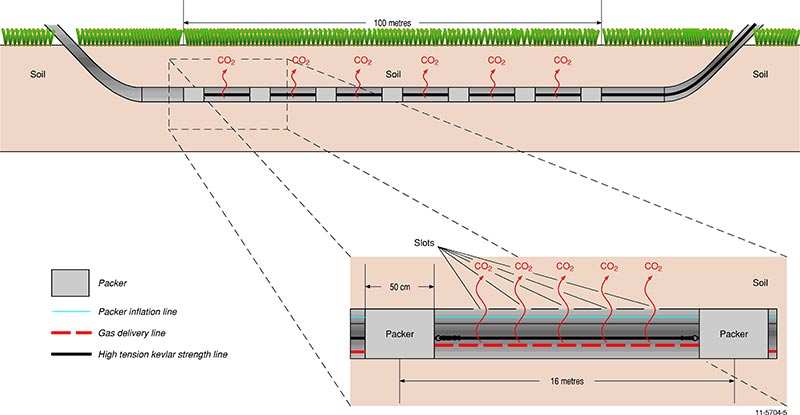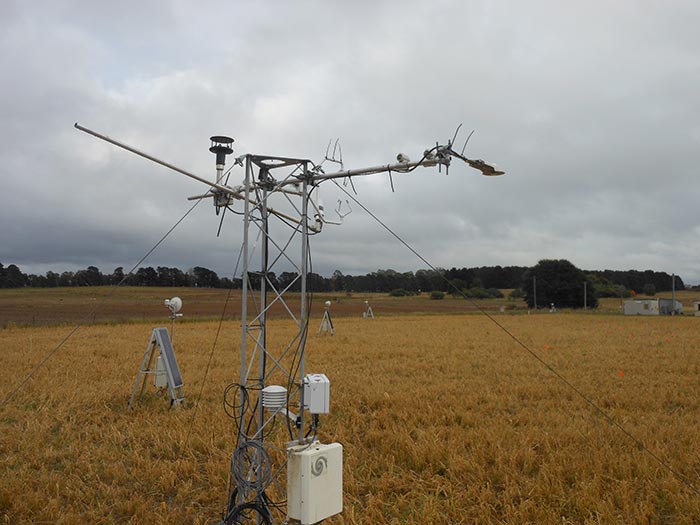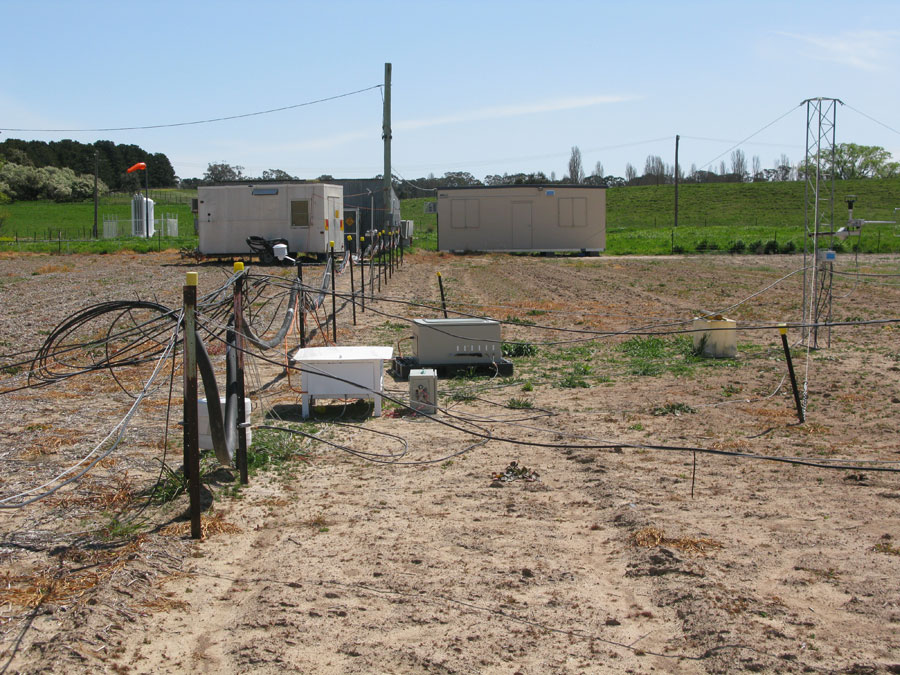Controlled Release Studies
Page last updated:4 December 2017
Above Ground Release Experiment (April - June 2015)
An above ground methane and carbon dioxide release experiment was held from April - June 2015. The experiment provided an opportunity to compare 8 different atmospheric emission quantification techniques against a simulated CH4 and CO2 point source release, where the actual release rates were unknown to the participants. An ensemble approach to estimating the CH4 emission rate proved successful with the ensemble median estimate within 16% for the actual release rate for the blind release experiment and within 2% once the release rate was known. Participants in the trial were Geoscience Australia, University of Wollongong, University of Melbourne, Macquarie University, CSIRO Energy , CSIRO Oceans and Atmosphere, Western Sydney University, CSIRO Data 61, University of Adelaide, CSIRO Mineral Resources , University of Western Australia, National Geosequestration Laboratory, Bruker Optik, FLIR, Department of Industry, Innovation and Science and CO2CRC. The results were published in Feitz et al (2017).
Ginninderra Controlled Release Facility Dataset
Geoscience Australia and the CO2CRC hosted 3 sub-surface release experiments at the CSIRO Ginninderra Experiment Station in Canberra, Australia from 2012-2013.
The facility enabled researchers to study emissions of carbon dioxide (CO2) (and tracer gases) from the soil into the atmosphere under controlled conditions. Over 20 monitoring techniques were trialled and all data (and associated metadata) can be downloaded for free.
Major findings
- Developed a new atmospheric method for quantifying CO2 emissions.
- Leak location can move depending on climatic conditions, groundwater levels and the extent of the vadose zone.
- Surface leakage is patchy and this is also observed in other controlled release facilities internationally. This new finding can be used to better inform monitoring strategies for geological storage sites.
- Successfully demonstrated that is it possible to use airborne detection of a small CO2 leak using a small helicopter UAV.
- Found significant lateral sub-surface migration in the near surface through the use of tracers, fundamentally changing perceptions of how CO2 migrates and expresses in the near surface.
- Different soil flux interpolation methods can introduce very large (up to order of magnitude) errors in quantification emission estimates.
- The cubic interpolation is the best performing soil flux interpolation technique. The python code for this can be downloaded.
- Demonstrated that there are clear shifts in the soil microbial community related to a switch from aerobic to anaerobic respiration near a CO2 leak.
Description of the Facility
Geoscience Australia and the CO2CRC operated the Ginninderra controlled release facility from 2010 to 2015. The facility was equipped with a 2.5t liquid CO2 storage vessel, vaporiser and mass flow controller unit with a capacity for 6 individual metered CO2 gas streams (up to 600kg/d capacity in total). Injection of CO2 into the soil was via a 100m long slotted HDPE pipe installed horizontally 2m underground. This is fitted with a straddle packer system to partition the well into six CO2 injection chambers. The design was modelled on the Zero Emission Research and Technology Centre (ZERT) controlled release facility in Montana, USA.
Third Shallow Sub-surface Release Experiment (October - December 2013)
The third sub-surface CO2 experiment was held from October - December 2013. The purpose of the release experiment was to gain more insight into the impact of CO2 on plants, better map CO2 surface expression, and try to understand CO2 migration behavior in the sub-surface. The total daily CO2 release rate was 144 kg/d. Monitoring techniques trialled at the site during the release included:
- Mobile CO2 surveys
- Groundwater depth
- Eddy covariance
- Plant physiology and chemistry
- EM31
- EM38
- Soil gas
- Soil flux
- Krypton and helium tracers
- Airborne hyperspectral
Organisations contributing to the experiment include Geoscience Australia, CSIRO, Airborne Research Australia, Flinders University, China Geological Survey, National Geosequestration Laboratory, University of Western Australia, the CO2CRC and the University of Adelaide.
Second Shallow Sub-surface Release Experiment (October - December 2012)
The second sub-surface CO2 experiment was held from October - December 2012. The purpose of the release experiment was to explore the use of remote sensing and geophysical techniques for detecting CO2 leakage. The total daily CO2 release rate was 288 kg/d. Monitoring techniques trialled at the site during the release included:
- Airborne hyperspectral and imaging
- Ground hyperspectral and imaging (using Phenomobile)
- Soil flux
- Soil gas
- EM31
- EM38
Organisations contributing to the experiment include Geoscience Australia, CSIRO, Airborne Research Australia, Flinders University, the CO2CRC and the University of Adelaide.
First Shallow Sub-surface Release Experiment (March - May 2012)
The first sub-surface CO2 experiment was held from March - May 2012. The purpose of the release experiment was to evaluate different CO2 monitoring technologies and track the CO2 as is moved through the soil and into the atmosphere. The total daily CO2 release rate was 144 kg/d. Monitoring techniques trialled at the site during the release included:
- Eddy covariance
- Atmospheric tomography using a wireless networked array of solar powered CO2 stations
- Soil flux
- Soil gass
- EM31
- soil community DNA analysis
- krypton gas tracer studies (soil gas and air)
Organisations contributing to the experiment include Geoscience Australia, CSIRO, the CO2CRC and the University of Adelaide.
Above Ground Release Experiment (July - October 2010)
A surface release experiment was conducted at the site in conjunction with CSIRO Marine and Atmospheric Research, the CO2CRC and University of Wollongong Centre for Atmospheric Chemistry to explore the application of an atmospheric tomography technique to simultaneously determine the location and emission rate of a leak when both are unknown. Determination of emission rate was possible to within 3% of the true emission rate for CO2 and within 5% for nitrous oxide (N2O). Localisation occurred within 1m of the known location for both release species. The results were published in Humphries et al (2013).


